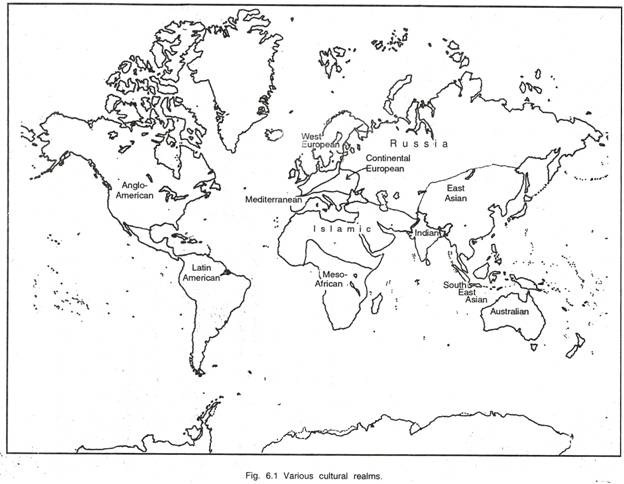ADVERTISEMENTS:
The major cultural realms are:
1. Occidental Realm
2. Islamic Realm
ADVERTISEMENTS:
3. Indian Realm
4. East Indian Realm
And the minor cultural realms are:
1. South-East Asian Realm
2. Meso-African or Negro African Realm. (Fig. 6.1).
 Occidental Realm:
Occidental Realm:
Occidental culture is the culture of the European society. It is influenced to a great extent by Christianity. It has regional modifications on the basis of varying levels of industrialisation, political and economic thought, colonisation, commercialisation, urbanisation, and development of transport system, land development of social, political and economic institutions.
In many parts of the occidental culture, the impact of non-religious factors, particularly the effect of modernisation, is so great that the religious values are sidelined. Post- industrial Europe is fast emerging as a society where traditional values are nearly abandoned. The occidental culture covers a vast area. It is further divided into six sub-regions considering the impact of regional environment.
(i) West European is the most industrialised and urbanised culture.
(ii) Continental European culture is influenced by different political and economic thoughts, while Christianity remains an important influence.
ADVERTISEMENTS:
(iii) Mediterranean Europe includes countries lying to the south of the Alps. It is the region of dominance of Christianity. To many geographers, the deep-rooted traditional social system is the principal cause of limited economic development in countries like Spain, Portugal and southern Italy, compared to countries of northern and western Europe which adopted necessary changes in their social systems.
(iv) Anglo-American and
(v) Australian cultural realms are practically the offspring’s of west European culture. Both are inhabited by migrants from west Europe. There are only some regional differences.
(vi) Latin American culture is very similar to the Mediterranean culture. It is the only region of occidental culture which lies in the tropics and is underdeveloped. It became a part of the occidental culture as a result of conversion of tribes into Christianity. The colonial languages, Spanish and Portuguese, have become the state languages. Regional architecture has been influenced by the Spanish and Portuguese styles. Practically all countries maintain economic, cultural and social ties with the Mediterranean countries.
Islamic Cultural Realm:
The culture here is influenced by Islamic values. It covers a vast geographical area from Morocco in the west to Pakistan in the east. The population is sparsely distributed due to inhospitable environment. The coasts, river basins and oases have been the cradles of Arabian culture in this realm. The British call it the Middle-East while the Germans call it a region of oriental culture. This cultural realm lies between the traditional Indian culture in the east and the modernised European culture in the west.
Islamic culture is highly orthodox and based on traditional beliefs, the impact of which can be seen in high female illiteracy rates. These countries have very high per capita incomes, but the level of modernisation is very low.
Indie Cultural Realm:
This is the culture of the Indian sub-continent. Baker called it a sub-continental culture, while D. Stamp used the term paddy culture. This cultural realm is well-defined; it lies between Himalayas in the north, Indian Ocean in the south and Hindukush Mountains in the west.
This cultural realm is characterized by joint family, village community, caste system, semi- feudal land relations, subsistence agriculture, paddy farming, seasonal climate changes and agricultural season coming at the same time all over the region. The culture of this region is greatly influenced by Vedic values. Though the region is inhabited by various communities, the social system has the hidden impact of Vedic cultural values.
East Asian Culture:
This culture is basically a Buddhist culture with regional modifications. True Buddhist culture can be seen in South Korea and Japan. Even these two countries have felt the impact of industrialisation, urbanisation and modernisation. The culture of mainland China has modified the Buddhist system. This culture was adopted after the Second World War.
ADVERTISEMENTS:
South-East Asian Culture It is a transitional culture lying at a place where different cultures have intermingled. Dominance of Buddhism can be seen in Myanmar, Thailand and Vietnam. Influence of Christianity can be seen in the Philippines and of Indie culture over islands of Indonesia. The Islamic influence is evident in Malaysia and the Indonesian islands. No other region has such peculiarities.
Meso-African Culture:
This culture is also known as the Negro culture. It principally includes tropical Africa. Similar cultural systems can be seen among the American Red Indians, Latin American tribes, Australian aboriginals and several tribes of Asia-Pacific region.
Historian Toynbee has used the term ‘marginalised culture’ for these traditional culture units. Some geographers even include Eskimos under this cultural realm. Thus, it is a widely scattered cultural realm characterised by marginalised and relatively isolated communities.
